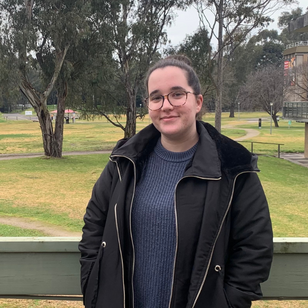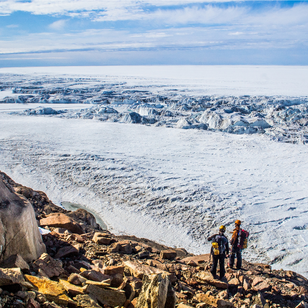Antarctic Futures

Antarctic Futures exhibition at the University of Wollongong. Source: University of Wollongong
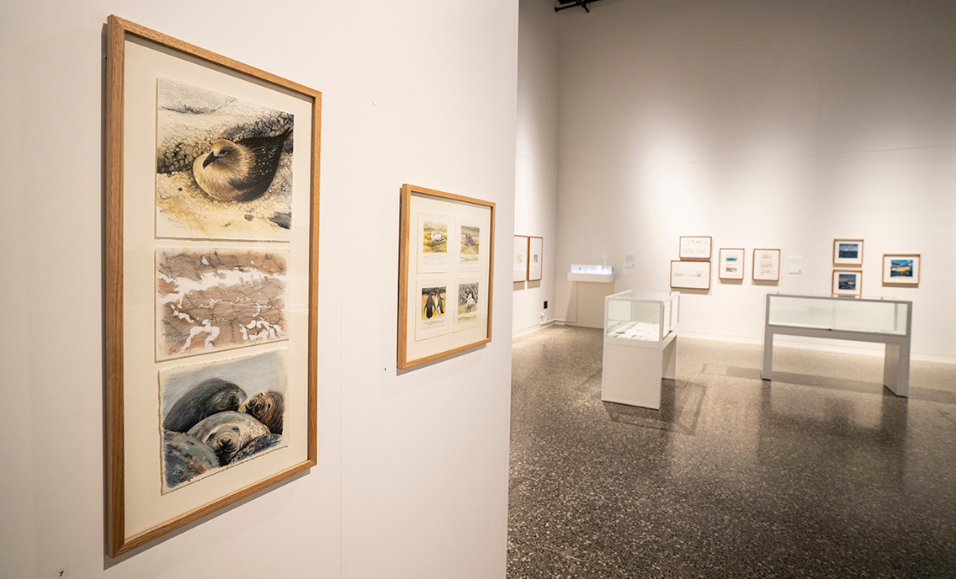
Antarctic Futures exhibition at the University of Wollongong. Source: University of Wollongong
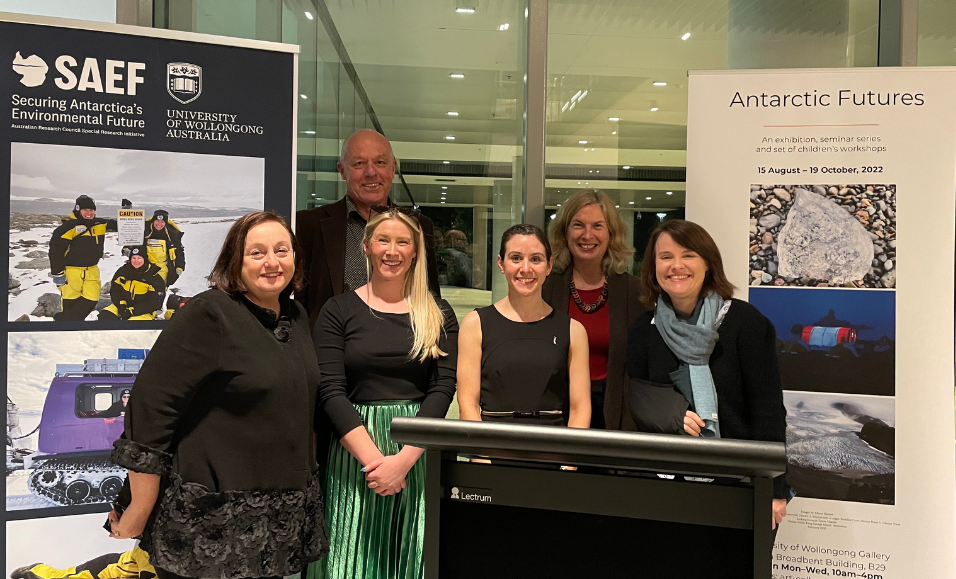
Professor Patricia Davidson, Associate Professor Brogan Bunt, Georgia Watson, Dr Melinda Waterman, Distinguished Professor Sharon Robinson and Professor Sue Bennett. Source: University of Wollongong
Scientists generally return from Antarctica with a wide-eyed sense of awe about how extraordinary the continent is. They have a sense of this before they visit, of course—but physically being in this place of extremes instils an entirely different appreciation for the continent. This coupled with that underlying drive most scientists have to understand the environment so that we can better protect it—more often than not has them wanting to share it with others.
Antarctic Futures
This is what inspired Antarctic Futures—a new exhibition, seminar series and early learning program at the University of Wollongong. Curated by Associate Professor Brogan Bunt, Distinguished Professor Sharon Robinson (SAEF Deputy Director of Science Implementation), Dr Melinda Waterman (SAEF Research Fellow) and Georgia Watson (SAEF Research Officer), it brings together the work of many scientists and artists who have visited Antarctica to consider the nature and future of the continent.
“Whether that’s through photographs, sketching snapshots of penguins, painting icebergs under different sunlight settings or invoking memories stored in ice, the artists in this exhibition all have stories about their time in Antarctica that they want to share,” Georgia says.
“The artworks in the exhibition highlight the beauty and magnificence of the place, the seminars will lead you to new ideas and inspiration, and the children’s workshops will engage our next generation of artists and scientists to be curious about Antarctica.”
Exploring Antarctica through art and science
The program seeks to combine both creative and conceptual aspects of environmental understanding to reflect upon potential futures for Antarctica under various climate, biodiversity and tourist scenarios.
“This series of events aims to spark curiosity and inspire creative problem-solving by exploring the links between artistic and scientific practices and perspectives. It poses the view that such a holistic approach is essential to comprehending and addressing wicked problems, of which Antarctica has many,” Georgia says.
Among the artists included in the exhibition is one of Australia’s leading contemporary artists, Janet Laurence. Her work explores notions of art, science, imagination, memory and loss through sculpture, installation, photography and video. Her works are held in collections around the world including those in Australia, Japan and Germany.
Janet travelled to Casey Station in Antarctica earlier this year alongside Georgia, Sharon and a small group of SAEF scientists as the recipient of the 2020 Australian Antarctic Arts Fellowship.
“I think all the works featured in this exhibition are gorgeous, but Janet Laurence’s work holds a special place in my heart,” Georgia says.
While down south, she was able to talk to Janet about her work and watch her create the pieces on show this exhibition in the science labs on station. In the works, Janet has made use of glacial ice, allowed to freely drip with ink to capture a map of memories unfolding as they melted.
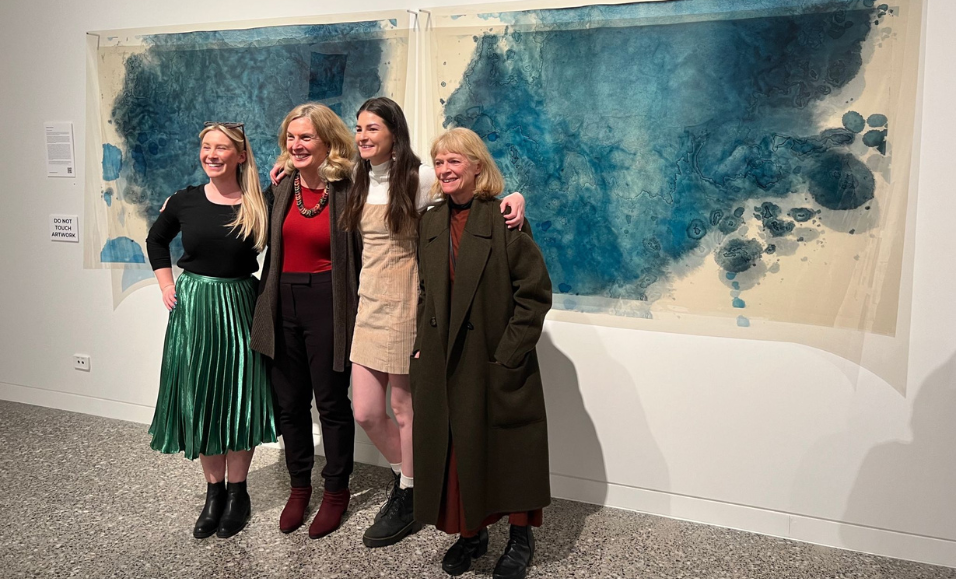
Georgia Watson, Sharon Robinson, Krystal Randall and Janet Laurence in front of Janet’s works. Source: University of Wollongong
Engaging young people
Wollongong boasts the world’s first children’s museum based at a university—the Early Start Discovery Space. It offers interactive experiences, educational programs and learn-through-play activities that are backed by University of Wollongong research. The curatorial team collaborated with the early learning team to create a program of play-based experiences about Antarctica for babies to 10-year-olds.
Children will be guided by early-learning educators through a program that includes a ‘Draw what you hear’ experience, interactive book readings and a play about tardigrades delightfully called ‘We’re going on a waterbear hunt!’ Children will also be encouraged to create artworks that reflect their interpretation of the theme “Antarctic futures” which will be incorporated into the exhibition over the course of its showing.
In Georgia’s opinion you’re never too young to start learning about and advocating for Antarctica.
“Young people bring with them new perspectives, new ideas and a sense of urgency for action on climate change and the extinction crisis. Antarctic science has so many opportunities for exploration, new discoveries and a system where management is always being reviewed and adapted for best practice,” Georgia says.
“This means you can make a real difference to the global community by learning about, advocating for and sharing your knowledge of Antarctica.”
Overall Georgia hopes that people engage with the idea that Antarctica is everyone’s responsibility.
“As Australians, we hold a great deal of custodianship due to the claim we hold over Antarctic Territory, and with that comes a duty to learn about and advocate for policies that will lead to a secure future for Antarctica.”
The team would like to acknowledge the funding and support received from Inspiring Australia for National Science Week, the UOW Early Start Program, the UOW Global Challenges Program, the UOW Centre for Sustainable Solutions, and Australian Research Council Special Research Initiative Securing Antarctica’s Environmental Future.
Antarctic Futures is open from 15 August – 19 October 2022. For more information: https://www.uowblogs.com/eco-antarctica/
